|
| |
The Maudes of
Burley-in-Wharfedale and Otley.

By Margaret Wigglesworth
My sincere thanks the Margaret
Wigglesworth for giving me permission to have this on my site
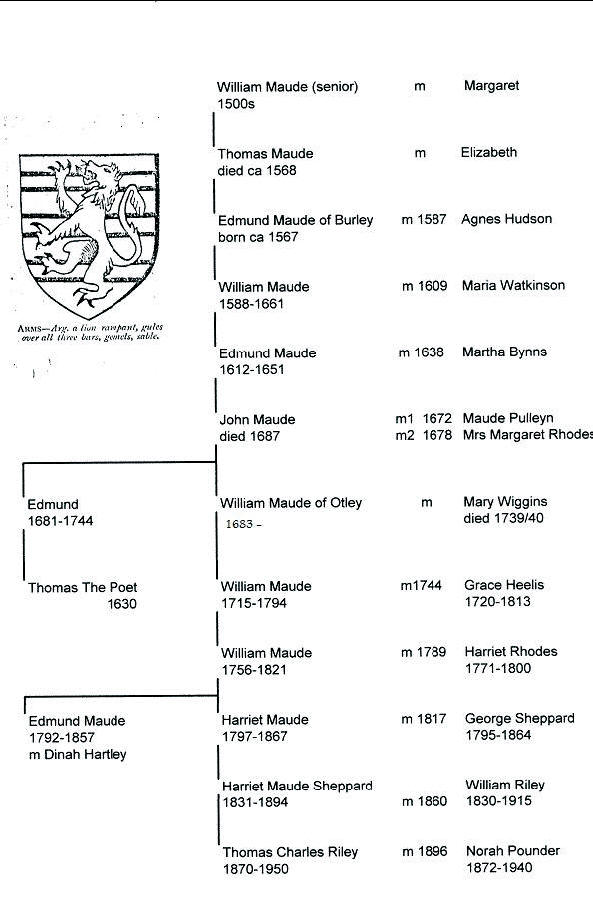
Home
At least as far back as the mid 1500s it
would seem that there were a
number of Maudes among the gentry in Wharfedale. Here I am totally
reliant on the antiquarian Harry Speight who produced companion volumes
of Lower and Upper Wharfedale, published in 1902 and 1900 respectively.
In them he included pedigrees for many of the leading families,
including Mawde of Helthwaite Hall and also Maude of Burley in
Wharfedale. He comments that from 1550, the Maudes at Burley "were
bristling with Williams and Edmunds" and on his Pedigree he shows a coat
of arms described as 'argent, a lion rampant, gules over all three bars,
gemels (a pair of bars placed close together), sable'. His earliest
mention of a Maude is of Richard of Burley Manor who married Joanna
Graver of Mensington (Menston, just south of Burley) 'before 1511'.
Richard is mentioned in the Burley Manor Rolls of 1526-43 and he owned
land in Burley and Mensington. A possible son, Bryan Mawde of Steyde
(Stead) in Burley, is mentioned in the Manor Rolls of 1541-47, as is
William Mawde junior from 1545-55. In the Manor Rolls of 1550-1555 we
have William Mawde senior who also had land in Burley and Mensington.
How these men were connected is not known. Another name which features
is that of Anthony Maude although again there is no known connection.
The Muster Roll in 1539 consisted of 'Archers, Horsed and harnessed,
Abyll persons' and Antony Maud from The Township of Otley is listed as
'Bylmen [sic] Horsed harnessed Abyll person'. In 1545 and again in 1546
a parliamentary grant to the sovereign (in this case Henry VIIIth) and
known as the Subsidy Rolls was levied for state needs. Among those taxed
was Anthonie Maude of Otley who paid £13 4s 4d (£13 22p) and £10 10s
(£10 50p) 'in Bonus', that is in respect of movables such as crops as
opposed to income from land, 'in terris'. These sums suggest that
Anthony was quite a wealthy man. Speight describes him as an important
figure among the Maudes. There were also Maudes, or Montaltes, at
Riddlesdon in the parish of Bingley some five or six miles south of
Ilkley who were said to be descended from the Earls of Northumberland
from before the Norman conquest. The many Maudes in west Yorkshire were
probably all related in some way.
According to Speight, however, it is from William Mawde senior that we
are descended. The only other thing we know about him is that his wife
was called Margaret and that she was the daughter of a freeholder of
Burley. Their son Thomas likewise had land in Burley and Mensington, his
wife was called Elizabeth and they had five children, four daughters and
a son Edmund. On 5th May 1568 he made his will in which he named his
mother who was presumably still living. This must have been shortly
before his death as his son Edmund was still only an infant. Nineteen
years later in 1587 Edmund married Agnes Hudson, daughter and coheir of
Stephen Hudson of Stead. In 1610 and again in 1621 Edmund was obliged to
pay tax of ijs viiid (2s 8d or 13 new pence) on land valued at xls (40
shillings or £2). He died in June 1654 and it would be interesting to
know the cause as an inquest was held 'p.m.', presumably on the same
day, as was the custom. From now on, we gradually learn more about the
Maudes from a number of different sources, beginning with Edmund's son.
William
Maude of Burley, 1588-1661
William was married in 1609 at Ilkley to Maria Watkinson and she must
have brought some money to the marriage as she was one of the legatees
of Thomas Mawde of Holling Hall, Ilkley in his will dated 1602. There
was no doubt a family connection here. In his will Thomas named William,
Henry, Edmund, Joseph, Mary, Isabel and Judith Watkinson, children of
Henry and Ephene Watkinson of Ilkley. They were to receive £40 each "in
full discharge of my promise to my sister Anne .... and to the same
children £40 each which I had of the gift of Christopher Robinson, their
godfather in 1590/1." The executor was Anthony Maud, Thomas's cousin. In
1554 Christopher Maude of Holling Hall was named as patron of Ilkley
Church. Maudes continued as patrons for almost a hundred years.
The name William Maude appears several times in the tax returns and one
assumes they all relate to the same William. As well as his father
Edmund, in 1610 and 1621 William was also being taxed, paying 1s 4d 'in
terris' in Menston on property valued at xxs (20 shillings or one
pound). By 1627 the tax had gone up to four shillings! In the same year
he was also paying four shillings 'in terris' worth xxs in Burley. As
his father had died three years previously William had probably
inherited property from him. In 1621 he had also had to pay three
shillings 'in bonis', in this case to the value of 47 shillings. This
was at Gaisley (Guiseley, immediately south of Menston). These were
further subsidy rolls, now paid to James I.
Burley was mentioned in the Anglo-Saxon Chronicles as early as 972 A.D.
and again in Domesday Book in 1087 where it was described as a berewick,
or outlying part of an estate, in the parish of Otley. In the Subsidy
Rolls paid to Edward III (in about 1330) De Thos. le Mohoud of the
Berewyk paid iijs (3 shillings).
It is believed that the first chapel in Burley, a very simple structure,
was built by the Lord of the Manor in the 13th century, probably as his
private chapel. In 1526, a Robert Wray bequeathed twenty pence for the
repair of the bell turret and to provide a torch for inside use.
Although it escaped being suppressed at the dissolution of the
monasteries it fell into disuse and became a ruin. The people of Burley
now had to go to church in Otley which, given the poor condition of the
road and frequent flooding, must have been difficult. In 1622 Sir Peter
Middleton, then Lord of the Manor, and his brother William sold their
property in Burley, including the ruined chapel and the land around it.
These came into the possession of Michael Stead, William Maude, Robert
Lambert and John Brown. In 1630 they handed over this property to the
Fairfax family who undertook to rebuild and re-endow the chapel and
chapel yard "for ever to the use of the minister to officiate".
Plan of the old Chapel, probably in the early 1700s
The Old Chapel, ca
1640, Burley-in-Wharfedale
This second chapel was ready for use in 1641. It was essentially a
preaching place although baptisms were held there at least from 1744. It
was a plain whitewashed building and seated about 180. It measured no
more than eighteen feet wide and fifty feet long and had a pulpit and
reading desk but no altar. There were thirty-five pews, the last six
being built 'at the common charge'. In other words these would be free
and reserved for the poor. A surviving plan, undated but probably made
in the early 1700s, shows that the largest pew, which was in prime
position at the east end, belonged to Thomas Pulleyn, Esq. As no fewer
than six other pews were also in his name he must have been the Lord of
the Manor with many of the pews for his household staff. Across the
aisle from Thomas Pulleyn's chief pew but facing from east to west, was
the pew of Mr Edmund Mawde. This is probably the son of John Maude and
father of the poet Thomas. It remained as a chapel-of-ease in the parish
of Otley until 1856 and until then weddings had to take place at Otley.
The original benefactors of this second chapel included Lord Fairfax,
William Maude, Edward Maude, (It is more likely that this was Edmund
Maude, William's eldest son), and Francis Pulleyne, who was Lord of the
Manor at the time and whose daughter was the first wife of Edmund's son
John. They endowed the chapel with an annual income of £16-13s while
William Vavasour of Stead bequeathed £4 per annum for ever. Speight says
he bequeathed Bowker's farm valued at £4 per annum but that it was
'never to be raised'. William Vavasour was the godfather of William's
son John, a legatee under Vavasour's will dated 1642.
In 1781 the following memorial tablet was erected by Thomas Maude, (see
below) but then it was lost for several years before being found in the
stables at Burley Hall by Dr Black, the vicar of Burley from 1855-96. By
then the chapel had been replaced by the present church and the tablet
was at first placed in the porch before being refurbished by the Rev. E.
N. Pedley (vicar from 1936-55) and removed to the west wall of the nave
where it now is.
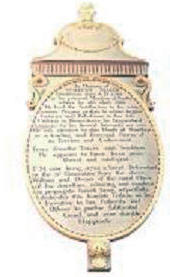
Memorial Plaque to William Maude [1558-1661]
In Memory of
WILLIAM MAUDE
Gentleman, born A.D. 1558,
in his paternal Mansion at Burley
where he also died, 1661.
He had the Satisfaction to see a nu-
-merous Progeny prosper to whom he gave
Fortunes and Possessions in his Life.
Uniform in Benevolence, he bequeathed
Legacies to his several Servants, nor was
He less attentive to this House of Worship
as a leading and Principal Patron of
its Erection and Endowment.
From domestic Traces and Tradition
He appears to have been pious,
liberal, and intelligent.
T.M. now living {1781} a lineal Descendant
in the 5th Generation from the above
William and Owner of the natal Place
of his Ancestors, admiring and emulous
to propagate honest Fame, respectfully
dedicates this humble Tribute, as an
Incentive to his Posterity and
Others, to pursue substantial
Good, and ever durable
Happiness.
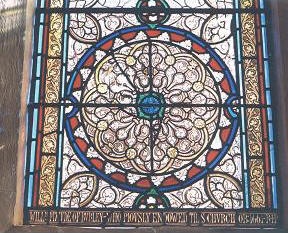
Stained glass windows were installed during the 19th century, one of
which is dedicated to
WILLM
MAUDE OF BURLEY - WHO PIOUSLY ENDOWED THIS CHURCH OB:1661 -
RIP
That he was still being remembered two hundred years after his death
suggests that William Maude had been a much respected as well as wealthy
figure in 17th century Burley. Burley was just a small village at the
time, with thatched cottages centred round the chapel, a village green
and stocks. The rough road to Otley was often flooded. A note in the
Parish Register records that the summer of 1603 was particularly wet,
causing the Wharfe to be flooded and bridges swept away. Two hundred
years later, when the chapel was taken down and the new church built,
the population had reached 1500.
William and Maria had at least ten children, five sons and five
daughters. The second son, John, 1620-57, was an Officer in Cromwell's
army and fought at the battle of Marston Moor. His descendants included
a number of distinguished men, including Frederick Philip Maude of the
Inner Temple, Barrister-at-law and joint author of Maude and Pollock's
Law of Merchant Shipping; Rear-Admiral William Maude of Burley who died
in 1843 and William Henry Maude, called after his godfather, the Duke of
Clarence, later William IV.
Edmund Maude 1612-51.
In 1638 Edmund married Martha Bynns, the daughter of Abraham Bynns, J.P.
of Rishworth Hall, Bingley and Sybell Waller. They had six children, the
eldest, William, born in 1640 appears not to have married. Although his
baptism has not been found, it seems safe to assume that there was a
second son, John, and that it is from him that we are descended. In 1672
a Mr Binns of Bingley paid tax on eight hearths (see below); presumably
this was at Rishworth Hall.
John Maude died 1687.
In 1672 John married Maud Pulleyn, daughter of Francis Pulleyne, Lord of
the Manor of Burley, and they appear to have had four daughters, two of
whom died shortly after their birth, and also a son who was stillborn.
The last of their children, Sarah, was baptised on 26th August 1677 and
was buried two weeks later, on 9th September. It seems probable that
Maud died in childbirth or shortly afterwards for little more than a
year later, on 11th December 1678, John remarried. His second wife was a
widow, Mrs Margaret Rhodes of Menston, and they had equal misfortune.
Their first two children, William and Jane, both died shortly after
birth, as did another daughter, Margaret. Then on 27th July 1687, their
last child, John, was baptised only to be buried six years later, "son
of the late Mr John Mawd of Burley, Gentle- man." He and his wife had
both died in 1687, Margaret probably in giving birth to John. The parish
register records 'John Maud of Burley, gent. bur. in Linen.' Although
there was more than one John Maud living in Burley at the time, we
almost certainly have members of the same family here as the Parish
Register always gives their father as Mr John Mawde of Burley.
The next tax for which we have names was the Hearth Tax. This was
introduced in 1662 'it being easy to tell the number of hearths, which
remove not as heads or polls do'. (Quoted by David Hey in his Oxford
Companion to Local and Family History). The tax was the major source of
revenue for the government but was very unpopular and was abolished in
1688. It was based on the number of hearths or chimneys that the
occupier of the house possessed. They were liable to pay two shillings
on each hearth, to be collected in two instalments, Lady Day (March
25th) and Michaelmas (September 29th). The tax collectors, known as the
chimney men, were particularly hated. They could enter people's houses
to count the hearths and would sometimes act in a very officious manner,
acting like modern day bailiffs and confiscating property if the
householders could not pay. There were exemptions for the poor. The
existing lists for Lady Day 1672 contain the names of several Maudes,
including John Maude of Burley with seven hearths. It seems probable
that this was our John. The fact that in the parish register he is
referred to as Mr John Maude, Gentleman and that he was buried in linen
suggests that he was a man of some wealth. Four other Maudes paid
hearth tax, John Junior with one, James Maude with two and Mr Major
Maude, with four, all of Burley, while a William Maude had two in
Menston We know that Major Maude was William and Maria's youngest son
and John's uncle and William may have been John's brother but who John
Junior and James were I don't know.
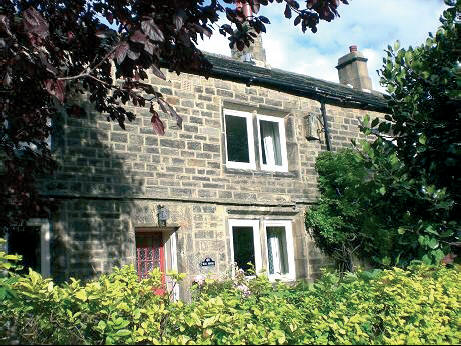
The Dial House, Burley-in-Wharfedale
Still standing on the main street in Burley is Dial House and high up on
the house wall is a stone sundial. It is somewhat eroded and there is
now no sign of the initials I[J] M and the date 1685 which were there
originally. There are several other old stone houses in Burley which
originally had initials carved into the stonework and bore the dates
1613, 1647 and 1680 (also I M). Two of the sons of John and Margaret
survived to adulthood, Edmund, baptised in 1682, and a second William,
baptised the following year.
Thomas
Maude the Poet, 1718-98
It was Edmund's third son, Thomas, who in 1781 erected the plaque to
William of Burley. He himself had an interesting life. Born in 1718, he
is thought to have trained as a surgeon in which capacity he served on
the ship Barfleur under Captain Paulett. In 1765 Paulett succeeded as
Duke of Bolton and appointed Thomas as steward to his extensive estates.
From then until the Duke's death in 1794 Thomas spent most of his time
at Bolton Hall in Wensleydale, north Yorkshire. He must at least have
visited his estate in Burley for in 1783 he built Burley House 'upon the
foundations of an old and respectable mansion which had stood 150
years'. We are told that the rooms were all papered and hung throughout
with bells. In 1788 it was advertised to be let for a number of years
and this ties in with Thomas being at Bolton. On the Duke's death he
returned to Burley where he is believed to have died. He was, however,
buried in Wensley churchyard (between Leyburn and Castle Bolton in
Wensleydale) with an elaborate altar [table?] tomb 'Sacred to the Memory
of Thomas Maude Esq. of Burley'. There followed a long verse and the
date Dec 23rd 1798. (Poets of Yorkshire, published 1868) [Speight gives
the date 3rd Sept]
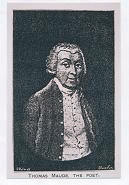
Thomas Maude, The Poet, 1718-98
He was known as 'Thomas Maude, The Poet' and was 'the author of Verbeia,
or Wharfedale, a work of superior merit, as well as of an equally
admirable composition, in verse, with valuable notes, entitled
Wensleydale, or Rural Contemplations; the latter [being] published for
the benefit of the Leeds Infirmary.' (Speight) Speight goes on to say
how he was 'privileged to present [Thomas's] portrait, admirably
reproduced from a scarce miniature in colours. In the original the coat
is blue and the waistcoat white with blue spots'. According to Poets of
Yorkshire, Thomas was born either in Downing Street, Westminster, or at
Harewood although there is no record in the Parish Register. We are then
told, somewhat confusingly, that Thomas says in his Verbeia, "T'was
there in guileless hour my race began".
William
Maude of Otley, 1683-
It is the second surviving son of John and Margaret, another William,
from whom we are descended. He married Mary Wiggins, the daughter of
James Wiggins of Tadcaster and they seem to have had several children, a
number dying as infants: 1707 - Martha, 1708-9 Mary, 1710-11 William,
1712-13/4 Sarah and in 1715 another William. If these are indeed the
children of William and Mary it suggests that they were married in about
1706. The only other firm knowledge we have is that Mary was buried in
Otley on 13th February 1739/40, 'wife of William Maude Gunsmyth.'
Writing in 1962, Fred Morrrell in Craftsmen of Years Gone By, mentions a
pair of silver-mounted pistols marked 'William Maude, Otley' and "now in
the collection of Francis Festing, Chief of the Imperial General Staff".
Unfortunately we have no date for these pistols but it could have been
this William or possibly his son who made them. Doreen Smith writing
about Otley mentions "William Maudes, ironmongers and silverplaters"
while Speight tells us that "in former times" good business was done in
the bit, stirrup and silver-plating trades, carried on principally at
the old Silver Mills near the east Chevin. We know that the next William
was an ironmonger and his son William was a silverplater. By the late
18th century there were Maudes, silverplaters, associated with a
double-fronted house on Kirkgate, Whitaker's Vaults and Maude's Yard.
[Much of this information came from our late cousin Pauline Barker.]
William
Maude 1715-94
As we have just seen, this William was an ironmonger. In 1744 he married
Grace Heelis. She was the daughter of Edward and Leah Heelis of
Skibden, a hamlet between Skipton and Bolton Abbey in the parish of
Skipton. They were married at Bolton but curiously, there is an entry in
the Otley parish register where details of their marriage had been
started and then crossed out.
Grace's great-uncle, Silvester Petyt, had been a successful lawyer in
London and at his death in 1719 he left over £30,000. After numerous
bequests a trust was established to administer the residue of his estate
and numerous 'poor' relations benefited, including Grace who between
1747 and 1755 received yearly payments of between £2 and £2 9s [£2.45].
In 1750 William himself had £7 to take his young brother-in-law,
Silvester Heelis, as an apprentice. (Silvester subsequently became a
hardwareman in his home town of Skipton.) Grace and William had eight
children. Their second son, William, was born on 29th June 1747 but died
the same day. In 1756 they had another son whom they called William and
it is from him that we can trace our line of descent.
William
Maude 1756-1821.
We have a number of references to this William allowing us at least a
glimpse of him as a person. Otley Parish Register records that 'Wm.
Maude Jnr. Ironmonger married Harriet Rhodes 4 March 1789 at Otley by
licence.' A licence would be necessary because Harriet was a minor and
needed her parent's consent. Two days earlier William had taken out a
Marriage Bond of two hundred pounds: William Maude of Otley ....
Ironmonger .... of the age of 25 years and upwards [8 years upwards, he
was 33!] and a batchelor [sic] .... intends to marry Harriet Rhodes of
the Parish of Otley .... aged 18 years and upwards [her eighteenth
birthday was on 3rd March!] and a spinster by and with the consent of
Ann Rhodes her natural and lawful mother. And he prayed a licence to
solemnize the said Marriage in the Parish Church of Otley .... signed
Wm. Maude Junior. On the same day appeared also personally the said Ann
Rhodes ... signed Ann Rhodes .... sworn before Jas. Bailey.
William's wife Harriet was the daughter of William and Ann Rhodes of
Leeds. When they moved to Otley is not known, nor when her father died
but, as we can see from the marriage bond, it was Ann who consented to
the marriage in 1789, at which time they were living in Otley. Ann died
and was buried in Otley six years later when she was described as a
widow, late of Leeds. There was a William Rhodes in Otley who was a
silverplater who may have been Harriet's older brother, baptised in
Leeds in 1764. In 1829 Harriet's niece, Elinor Sheppard, married a James
Rhodes of Otley who could have been the silverplater William's son but
more probably he was the son of Peter Rhodes, fellmonger. Unfortunately
both William and James Rhodes were common names in Leeds and Otley and
so far I have been unable to sort them out with any degree of confidence.
Already in 1792 William Maude Junior was a man of some wealth and the
Land Tax returns for that year list several properties on which he paid
a total of £1 4s 3½ d [£1 22p], including 6d for a shop. However he and
Harriet were living in a house belonging to Richard Holdsworth, a
wealthy maltster, who paid tax of 1s 10d [9p].
'William Maude junior, ironmonger of Otley' appears in the Universal
British Directory for the years 1792-7, still distinguishing him from
his father 'William Maude of Otley, Iron-
monger buried November 1794.' By the time his children were baptised he
is more than once described as Silverplater. On the other hand, Briggs
in his pedigree describes him as Banker and in Otley Museum are two
Otley banknotes bearing his signature and the dates 1st and 4th July
1815. During the 18th century savings banks were established in most
provincial towns. Unfortunately they frequently failed and within a few
years Maude and Co. had stopped payments.
In all probability it was this William Maude rather than his father who,
sometime in the late 1700s, became one of the partners in an enterprise
initiated by John Walker of Otley, who was a silverplater. Another
member was Richard Holdsworth in whose house William was living in 1792.
A few miles north of Otley is the Washburn Valley where for centuries
the spinning of wool and linen had been an important part of its
economy. In 1791 Walker and his partners bought an old corn mill and
millpond for £530 at West End. On the site they built a spacious textile
mill, using water power for spinning cotton and close by they built
thirteen cottages to house the workers. The company went on to buy two
more mills but by 1805 William Maude and others had withdrawn from the
partnership. By the 1830s the West End mills were beginning to decline
and although Walker's mill survived into the 1840s and continued to be
used on and off under different tenants, in 1890 John Walker's
descendants tried to sell it for £3000. No buyer was found and in 1901
it was bought by Leeds Corporation by compulsory purchase. Three
reservoirs had been built in the 1870s lower down the valley and the
intention was to build another where the mill stood. It was not until
1960 that work finally began and 1966 when Thruscross Dam was officially
opened. Among the buildings submerged was Thruscross Holy Trinity Church
and a new one was built further up the valley using stones from Walker's
mill .(West End - A Sunken Village by Alastair Laurence 1992)
All was not well however for in 1817 William, together with his brother
Edmund, was declared bankrupt. On 10th May 'a Commission of Bankrupt
[was] awarded and issued against WILLIAM MAUDE and EDMUND MAUDE, both of
Otley .... Bankers, Dealers, Chapmen, and Copartners, carrying on
Business together at Otley .... under the Firm of William Maude and
Company.' (No mention of ironmonger) Three years later their
considerable property was put up for auction in no fewer than eight
lots. There were at least seven messuages, all rented out and including
'A Capital Freehold MESSUAGE, situate in Kirkgate, in Otley, now in the
occupation of .... William Maude, with large and commodious
newly-erected Spirit Warehouse, and other Outbuildings and Conveniences
therewith occupied.' There were also several closes of land, in all
about twenty-four acres. William died the following year but Edmund, as
we shall see, evidently went on to become a successful wine and sprit
merchant.
William and Harriet had six children, the last being Sarah, born on 17th
January 1800. Harriet, no doubt as a consequence, died less than four
months later on 30th April. Sarah however survived and in 1828 she
married John Newsom Brigg. W. Brigg, who produced the Maude Pedigree
from the marriage of William and Grace onwards, was doubtless their son.
Following Harriet's death, William subsequently remarried, this time to
a Sarah Robinson.
William and Harriet's eldest child was William Rhodes Maude. We know
from his sister- in-law Dinah Maude's will that he had a son James who
was a tobacconist in Liverpool and that he in turn had a son John who
was a beneficiary under Dinah's will. Their next child, Ann Rhodes Maude
lived only a few months. They had a son John who married and had seven
children, including an Edmund who, according to Briggs' pedigree, went
to Brazil in 1868, returning to England four years later! The other two
children, Edmund and Harriet lived all their lives in Otley and various
documents suggest that they were close friends.
Edmund, 1792-1857
. Despite his bankruptcy in 1820, Edmund went on to
become a successful Wholesale and Retail Spirit Dealer at Whitakers Arms
in Kirkgate. He eventually obtained an Inn Licence when the property
became known as Kirkgate Vaults and Whitaker's Vaults. To the left of
the public house was Maude's Yard where there were two or three
cottages. (Old Otley by Elise Brumfitt, 1986.) Baines Directory for 1822
describes Edmund Maude as 'Wine and Spirit Merchant (raff and iron
merchant & sub-distributor of stamps), Kirkgate.' Raff appears to have
been the same as riff-raff, defined in the dictionary as rubbish.
Following Edmund's death in 1857, his widow continued to be listed in
the directories as licensed to sell Wine, Spirit and Porter up to the
time of her own death in 1869.
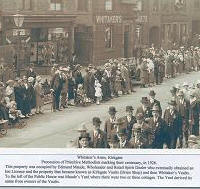
Whitaker’s Vaults, Kirkgate,
Otley, 1926
In 1824 Edmund married Dinah Hartley. They had no children and when
Dinah, by then a widow, made her will in 1865 she made bequests to her
seven 'Maude' nieces, including Elizabeth and Harriet, daughters of
Harriet Sheppard, who between them were to receive all the plate which
formerly belonged to my late husband's family and on which is engraved
the initial letters of their names (except the Silver Tea Service given
to me on my marriage). This would go to her sister Hannah Deighton who
was the main beneficiary. It is interesting to note that her books were
to go to a man, John Maude, the son of her late nephew, James.
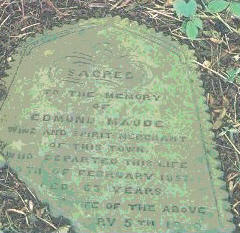
The Tombstone of Edmund and Dinah Maude, Otley Churchyard
SACRED
TO THE MEMORY
OF
EDMUND MAUDE
WINE AND SPIRIT MERCHANT
OF THIS TOWN
WHO DEPARTED THIS LIFE
*0 TH OF FEBRUARY 1857
*GED 63 YEARS
***** WIFE OF THE ABOVE
*********RY 5TH 18**
Although
Dinah died on 5th January 1869 the Leeds and Yorkshire Fire Register for
Lady Day 1869 includes a list of property and household effects that had
been insured by her. In addition to her personal 'household goods,
Linen, wearing apparel, printed books, plate and stock in trade' to the
value of £140, was a shop used as Spirit Vaults as well as a wine and
spirit warehouse, plus stock consisting of 'Wines and Spirits, Casks,
Barrels, and Utensils' valued at £150. There were also five Dwelling
houses which were rented out..
Edmund and Dinah were buried at Otley parish church. Unfortunately their
headstone, when seen in the 1990s, was broken and hidden at the back of
the churchyard.
Harriet, 1797-1867 married George Sheppard. She too was under age and a
Marriage Bond, again for £200, was made: on the 4th day of March 1817
George Sheppard of Otley Solicitor of the age of 22 years and upwards
and a Bachelor intends to marry Harriet Maude of Otley aged nineteen
years and upwards and a Spinster with the consent of William Maude the
natural and lawful father of the said Minor. Their marriage the
following day was witnessed by William and Edmund Maude. Many years
later, Edmund's widow Dinah was to witness Harriet's will.
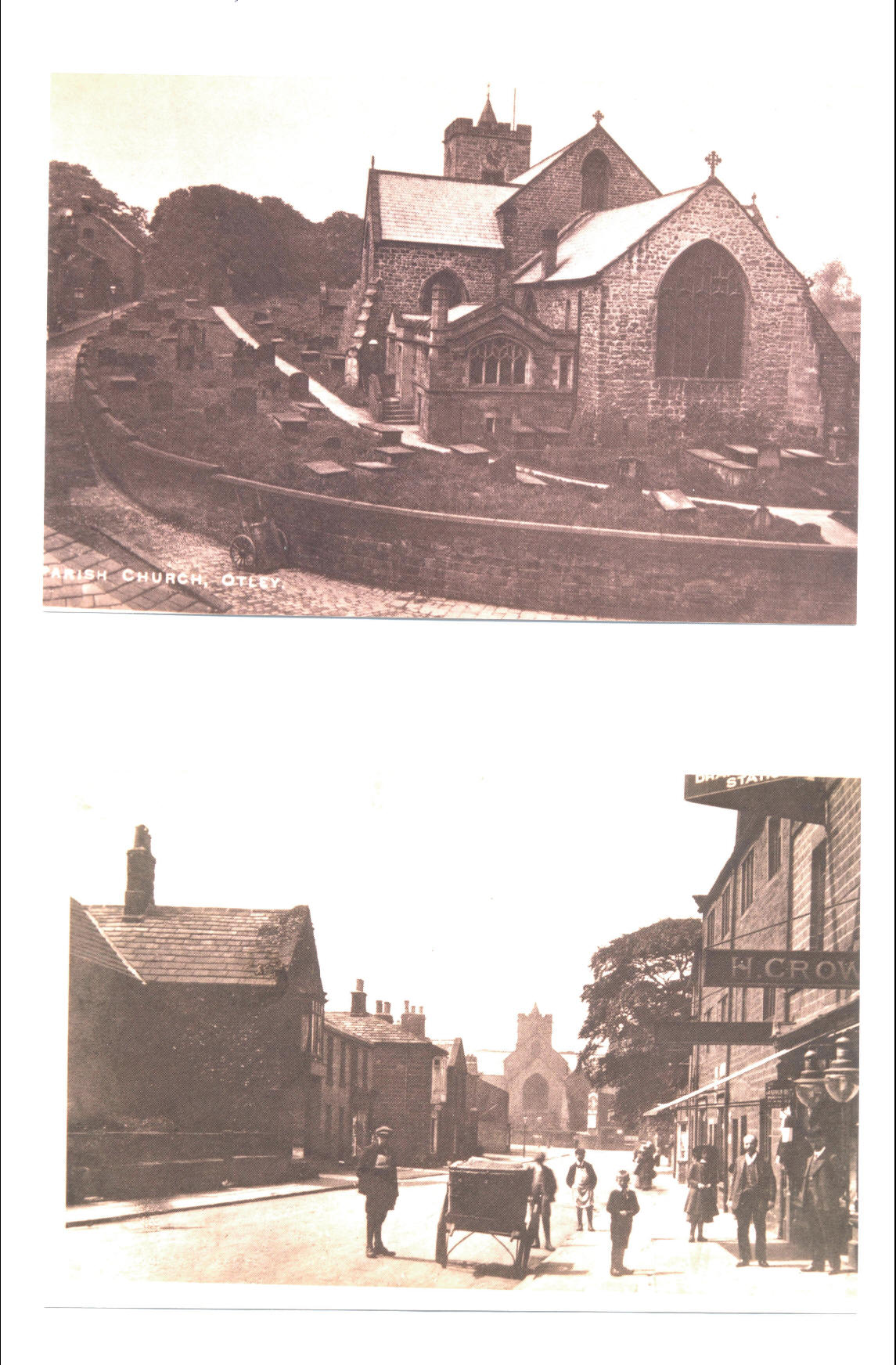
Otley Church
Bibliography
Harry Speight Lower and Upper Wharfedale, 1902 and 1900
F.W.M. Newbold A Short History of the Parish Church of Saint
Mary The Blessed Virgin, Burley-in-Wharfedale,
compiled from various sources.
Fred Morrell Craftsmen of Years Gone By. 1962
Elise Brumfitt Old Otley. 1986
Alastair Laurence West End - A Sunken Village. 1992
Leeds Mercury 1817 and 1820
Otley Parish Registers
Trade Directories
Otley Museum Various
END
TOP
| |
|
